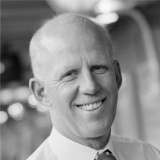
Photos: SJ AB
1 Jun 2009
High-speed trains cut distance and save nature
The Swedish railway system has great challenges ahead of it. As travelling by train is becoming even more popular, both the capacity of the railways and the power supply need to be increased.
Significant infrastructure development is needed to maintain the competitive advantage of the railway in Sweden.
CEO Jan Forsberg of the Swedish passenger railway company SJ AB says that the biggest challenge is keeping to timetables.
“A general rule is that a maximum of 80% of the railway capacity should be in use. This concerns both the rail network and the power supply. On our railways, the capacity reaches 100% continually. As the railways and the power supply are overloaded, even a small delay is dramatic. A domino effect starts, and all trains are delayed,” says Mr Forsberg.

“We need to be reliable in order to be able to compete with airlines and cars.”
Jan Forsberg
CEO of SJ AB
Due to the load on the infrastructure, it is difficult to increase the number of departures, but it is possible to make the trains longer. SJ assumes that expanded train capacity will increase the market share of train travel. In Sweden, around 15% of journeys over 100 kilometres are travelled by train, almost 70% by car, 13% by air and 5% by bus.
Competition is increasing
Not only cars, planes and buses are competitors of SJ. A law on the deregulation of passenger train traffic in the country, which will come into effect in the beginning of January 2010, will change the competition significantly. The deregulation opens the market for any railway company and allows any service provider to start trafficking on Swedish railways.
“On the other hand, for the deregulation and competition to work, we need to increase the network and power supply. If the infrastructure capacity cannot absorb the increase in traffic, other service providers will not be interested in entering the market,” says Mr Forsberg.
A recent market study on high-speed rail traffic in Sweden, in which SJ has taken an active part, suggests that an expanded high-speed rail network would have substantial benefits for the country. Shorter travel times, enhanced possibilities to meet environmental targets and other advantages would add up to improved competitiveness for Sweden’s economy.
In Sweden, as well as in many other European countries, demand for highspeed train travel is increasing. SJ has responded to this demand by introducing new high-speed trains as well as engaging in product and service development. Fast and comfortable train services are vital for many parts of Sweden. High-speed trains make distances shorter and bring communities closer together.
Many studies have clearly shown that time is the most important factor when people consider means of travel. The decreased travel time in combination with higher departure frequency is assumed to lead to train travel taking market shares away from air and road travelling.
Added value attracts passengers
In order to attract new train travellers, SJ is focusing on providing passengers with added value. Old trains have been renewed, both visually and as concerns travel comfort. SJ has also put much effort into training and the development of its personnel with a view to improving the service-orientation among the staff.
Other services include improved restaurant carriages, conference compartments, office services, such as an Internet connection, as well as quiet compartments for those who want to work or relax on the train.
“Of course, basic things such as safety, punctuality and efficiency need to be in place, as well,” says Mr Forsberg.
Environment-friendly way of travelling
These days, when environmental issues are on everyone’s minds, the train has a strong advantage compared to cars and airplanes. SJ only buys renewable electricity from hydroelectric and wind power sources and the production of electricity for the trains causes minimal emissions.
For example, an average car emits 89 kilograms of carbon dioxide into the air during a one-way trip from Stockholm to Gothenburg, some 470 kilometres. An entire SJ train, carrying up to 300 passengers, emits 400 grams. The differences become even more pronounced if you compare trains with planes.
A single plane emits as much as six tonnes of carbon dioxide on that same route. According to Mr Forsberg, it is a force of habit that people go by car or by airplane instead of by train. By offering services and possibilities that neither cars nor aircraft can offer, SJ wants to encourage more people to use the train.
NIB financing for 20 high-speed trains
SJ has ordered 20 new high-speed trains from Canadian Bombardier Transportation. NIB is contributing to the financing with a loan of EUR 45 million.
“One of NIB’s focus areas is the financing of infrastructure investments. The development of infrastructure is a key factor for competitiveness,” says Ulf Westergård, Senior Manager of NIB.
SJ’s new trains will offer travellers reduced travel time and improved comfort. SJ operates passenger rail services from 350 stations and is the largest passenger railway operator in Sweden. SJ’s market share amounts to some 55% of all passenger train transport in Sweden.
